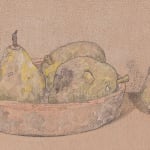H.P. Bremmer (1871-1956)
Hendricus Peter Bremmer, known as the genius art advisor behind the collection of Helene Kröller-Müller and Van Gogh’s prominent promoter, had a strong, charismatic personality and wielded great influence over public taste and acquisition in the Netherlands throughout the first half of the twentieth century. The versatile Bremmer, active as a critic, teacher, publisher, collector, dealer and connoisseur, first trained as an artist. From 1902 on, Bremmer lived at Artiestenhof, artist’s quarters in The Hague, where he would reside until his death in 1956. His home became a place of gathering for young Dutch and Belgian artists and writers, discussing the ideas of Emile Verhaeren, Vincent van Gogh, Jan Toorop, and Odilon Redon. His most lasting legacy is in his role as an art influencer, established after meeting Kröller-Müller in 1906, the wealthiest art patron in The Netherlands at the time.
Bremmer briefly attended the Royal Art Academy in The Hague, where he took the art teacher course in 1889-1890. Ending his artistic career six years later, his focus became teaching art appreciation and forming private collections.[1] Grounded in the fin de siècle and the religion and mysticism that pervaded it, Bremmer experienced art in terms of spirituality. Whether it was old masters, Delftware, Chinese figurines or Van Gogh: Bremmer searched for a visible reality forming the basis for his so-called ‘Practical Aesthetics’. His followers, the “Bremmerites”, devotion to art had all the features of a religion. Bremmer’s own eclectic collection consisted of already a thousand objects by 1911.[2] From Dutch old master paintings to the avant-garde from Bremmer’s youth: art from all periods and every part of the world were hung together. This overwhelming passion and ability to form ahistorical collections inspired his students to follow suit.
Bremmer’s paintings and drawings are rare. After his abbreviated attendance at the academy, he decided in 1892 to study independently. His studio practice was solidified in a pointillist style although his artistic output would remain limited to this early period. Familiar with the color theories of Ogden Rood and Michel Chevreuil, Bremmer introduced dots of colors directly following nature rather than scientific schemes.[3] Whereas Signac and other French and Belgian contemporaries would use these color theories for plein air landscapes, Bremmer applied this method also for still lifes. A few examples of his work are in the Kröller-Müller and other Dutch museums, and only one painting, a still life, is in a public collection in the United States in the Indianapolis Museum of Art.[4]
[1] Hildelies Balk & Lynne Richards, “A Finger in Every Pie: H. P. Bremmer and His Influence on the Dutch Art World in the First Half of the Twentieth Century”, Simiolus: Netherlands Quarterly for the History of Art, Vol. 32, No. 2/3 (2006), pp. 182-217
[2] H. Balk a.o., op.cit., p. 201
[3] J.M. Joosten, "De Leidse tijd van H.P. Bremmer 1871-1895", in: Jaarboekje voor geschiedenis en oudheidkunde van Leiden en omstreken 63 (1971), pp. 79-114
[4] Still life with books and Chinese vase, oil on canvas, 55 x 65.4 cm., no. 1992.1



